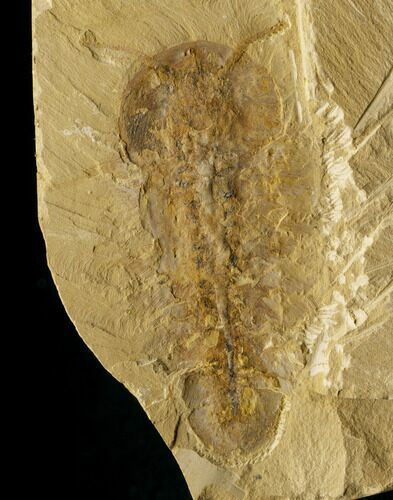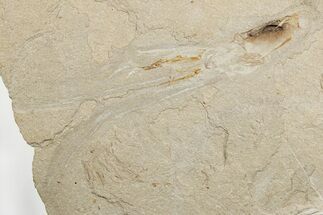This Specimen has been sold.
Stunning Soft-Bodied Naraoiid Arthropod (Misszhouia)
This is another exceptional offering from a high end collection of material primarily acquired in the 1980's and 1990's which is being sold through FossilEra.com The specimens from this collection represent some of the highest quality examples of their types found.
Please Note: The Chengjiang fossil beds are now a protected UNESCO World Heritage site and several different laws put in place over the past two decades effectively ban the export of nearly all fossils from China. This specimen was legally acquired by the collector in 1995-1996 prior to any export restrictions or restrictions on the Chengjiang fossil beds.
The Chengjiang region of China is noted for soft-tissue fossil finds. The Maotianshan Shale is considered “as spectacular as the Burgess Shale fauna and significantly older" Misszhouia is a genus of small to average sized (up to 6 centimetres (2.4 in) long) of soft-shelled marine arthropods within the Naraoiidae family, that lived during the Lower Cambrian (late Atdabanian).
The only species presently known is this one, Misszhouia longicaudata (and the genus is monotypic). The taxonomic placement of the soft bodied Naraoiidae has been controversial - though detailed appendages have been seen in some specimens that reveal biramous appendages which are very similar to true trilobites.
Misszhouia longicaudata is almost flat. The upper (or dorsal) side of the body consists of a non-calcified headshield (cephalon) and tailshield (pygidium) without body segments between. The body is narrowed at the articulation between cephalon and pygidium. The long many-segmented antennae are directed forward. There are no eyes. The gut has a relatively small diameter, and there are four pairs of relatively small digestive sacs (or caeca) in the cephalon only, and no branches towards the edge of the cephalon (unlike Naraoia). There are 25 limb pairs with two branches on a common base, like Naraoia and trilobites.
This particular specimen shows many of these features with amazing clarity and detail. Note the antennae. It is also very large at 56mm - close to maximum size!
It is important to note that local phosphate mining brings in some 2/3 of the county's revenue, so there’s the dilemma between calls for preservation these amazing fossil sites and problems of finding a balance between exploitation and restoration of the land. Given the scientific significance of the fossils, efforts have been made to close the region to mining and restrict the collection of fossils in a bid to support Chengjiang listing as a World Heritage Site.
Please Note: The Chengjiang fossil beds are now a protected UNESCO World Heritage site and several different laws put in place over the past two decades effectively ban the export of nearly all fossils from China. This specimen was legally acquired by the collector in 1995-1996 prior to any export restrictions or restrictions on the Chengjiang fossil beds.
The Chengjiang region of China is noted for soft-tissue fossil finds. The Maotianshan Shale is considered “as spectacular as the Burgess Shale fauna and significantly older" Misszhouia is a genus of small to average sized (up to 6 centimetres (2.4 in) long) of soft-shelled marine arthropods within the Naraoiidae family, that lived during the Lower Cambrian (late Atdabanian).
The only species presently known is this one, Misszhouia longicaudata (and the genus is monotypic). The taxonomic placement of the soft bodied Naraoiidae has been controversial - though detailed appendages have been seen in some specimens that reveal biramous appendages which are very similar to true trilobites.
Misszhouia longicaudata is almost flat. The upper (or dorsal) side of the body consists of a non-calcified headshield (cephalon) and tailshield (pygidium) without body segments between. The body is narrowed at the articulation between cephalon and pygidium. The long many-segmented antennae are directed forward. There are no eyes. The gut has a relatively small diameter, and there are four pairs of relatively small digestive sacs (or caeca) in the cephalon only, and no branches towards the edge of the cephalon (unlike Naraoia). There are 25 limb pairs with two branches on a common base, like Naraoia and trilobites.
This particular specimen shows many of these features with amazing clarity and detail. Note the antennae. It is also very large at 56mm - close to maximum size!
It is important to note that local phosphate mining brings in some 2/3 of the county's revenue, so there’s the dilemma between calls for preservation these amazing fossil sites and problems of finding a balance between exploitation and restoration of the land. Given the scientific significance of the fossils, efforts have been made to close the region to mining and restrict the collection of fossils in a bid to support Chengjiang listing as a World Heritage Site.
SPECIES
Misszhouia longicaudata
LOCATION
Maotia’shan shale -Chengjiang, Yunnan, China
FORMATION
Yu'anshan Member of the Heilinpu Formation
SIZE
2.2" long on 2.9" matrix
CATEGORY
ITEM
#14931
We guarantee the authenticity of all of our specimens.
 Reviews
Reviews











